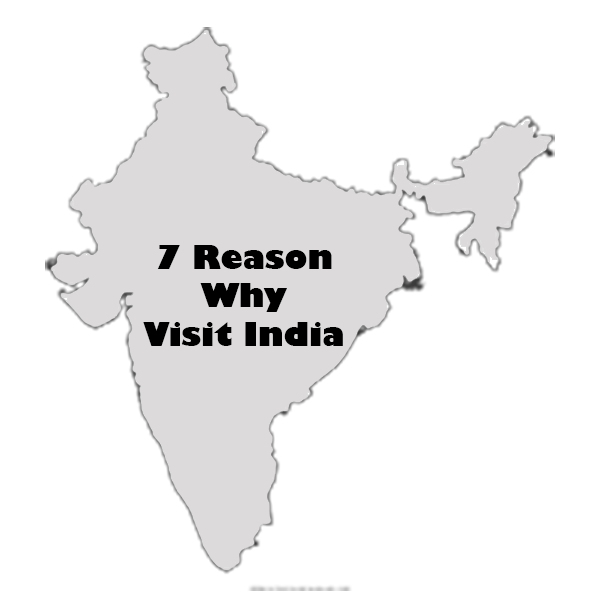Discover
7 Reasons
Why Visit India

India is one of the most compelling travel destinations in the world with its vibrant cultures, rich history, spectacular landscapes, and spiritual heritage. 7 reasons why visit India has all the reasons why one should visit India. From snow-covered summits of the Himalayas to dusty sunny seashores in Goa, from the structural magnificence of Rajasthan’s forts to the brilliant backwaters of Kerala, India provides experiences to all kinds of travelers. India is a land of diversity, and its unique offerings ensure a journey unlike any other, whether you’re seeking adventure, spirituality, history, or relaxation. Here are the 7 reasons why visit India.
Historical and Cultural Tourism
The history of India spans thousands of years, and the subcontinent shelters some of the world’s most famous historical sites. Taj Mahal, a grand temple of love built by Mughal Emperor Shah Jahan, is in Agra, India. It is also a UNESCO World Heritage Site and one of the Seven Wonders of the World. The Pink City, Jaipur, is home to Rajput architecture with phenomenal forts such as Amer Fort and palaces like Hawa Mahal. The capital city of Delhi is home to historical highlights, including the Red Fort, Qutub Minar, and Humayun’s Tomb, which all represent different parts of India’s past.
Beyond the monuments, India is a land of culture, art, and experiences. Traditional dance forms like Bharatanatyam, Kathak, and Odissi offer a peek into the country’s rich artistic heritage. Cultural festivals such as Diwali, Holi, and Navratri color the streets with joy and warmth throughout the country. India is widely regarded as the best place to celebrate cultural festivals. It is one of the 7 reasons why visit India.
Spiritual Tourism
India is known for being the birthplace of numerous major religions such as Hinduism, Buddhism, Jainism, and Sikhism, thus making it a high-status spiritual hub. Varanasi, one of the oldest living cities, is the spiritual heart of India. The Ganga Aarti at Dashashwamedh Ghat is a thrilling experience that pulls thousands of devotees and tourists along. Bodh Gaya is where Gautama Buddha attained enlightenment under the Bodhi tree. It is an important pilgrim center for Buddhists around the world.
Amritsar’s Golden Temple, Sikhi’s most holy shrine, greets visitors with the inviting ambiance of its sacred grounds and the divine water (community meal) it serves. Rishikesh and Haridwar are yoga and meditation hubs in the foothills of the Himalayas that attract seekers of spiritual enlightenment from all over.
Adventure and Nature Tourism
India provides adrenaline seekers with a plethora of adventures. The best trekking trails like Roopkund, Valley of Flowers, and the frozen Zanskar River called Chadar Trek, etc. Khardung La; Biker’s Paradise: Road trips in Leh-Ladakh are adventurous and take you through some of the highest passes in the world.
From national parks to wildlife sanctuaries, wildlife lovers can explore more than 100. For tiger safaris, you can visit Ranthambore National Park in Rajasthan and Jim Corbett National Park in Uttarakhand. Kaziranga National Park in Assam, known for being a habitat of the one-horned rhinoceros, is a UNESCO World Heritage Site, and Periyar Wildlife Sanctuary in Kerala allows you to see elephants in the wild.
India boasts dazzling natural landscapes too. During your stay, do not miss the peaceful backwaters of Kerala, the beautiful beaches of Andaman and Nicobar Islands, and Goa and Gokarna, which offer you beautiful environments to relax and discover many water sports.
Culinary Tourism
Indian food is as diverse as its cultures and traditions. Biryani, kebabs, and butter chicken are famous Mughlai dishes. Savor the refreshing chaats, samosas, and parathas on the streets of Delhi. Dosa, Idli, and Sambar are some of the best South Indian spicy-tang foods. Goa’s seafood cuisine, laced with Portuguese flavors is a treat. Rajasthan has its special traditional food, such as dal baati churma and gatte ki sabzi.
Another highlight of Indian food culture is Bengali cuisine, which focuses on fish and sweets such as rasgulla and sandesh. You can also add: Mumbai’s vada pav, Kolkata’s puchkas, and Hyderabad’s Irani chai and Osmania biscuits for street food lovers.
Wellness and Ayurveda Tourism
However, people have often come to India for wellness tourism, particularly for Ayurveda and traditional healing therapies. Kerala is the home of Ayurveda, a popular treatment, and authentic rejuvenation therapies at specialized resorts. Rishikesh, with its label as the “Yoga Capital of the World,” draws upward of thousands of people every year for yoga and meditation retreats.
Ayurvedic massages, detox treatments, and holistic healing programs are offered in several wellness resorts across India, where physical and mental well-being is emphasized. Due to the relaxed atmosphere and old studies, such as Ayurveda, India is a place for a balanced and peaceful life for those seeking to bring their inner harmony.
Luxury and Heritage Tourism
India has some of the most luxurious travel options in the world. The country’s palace hotels, like the Taj Lake Palace in Udaipur and the Umaid Bhawan Palace in Jodhpur, offer a royal experience. Luxury train journeys of India like the Palace on Wheels and the Maharajas’ Express provide travelers with an opportunity to explore India in unmatched comfort and style.
Those looking for exclusivity can book private houseboat cruises in Kerala, desert camps in Jaisalmer, and luxury resorts in Goa and the Himalayas—all offering world-class en-suite hospitality.
Eco and Rural Tourism
Eco-tourism in India is picking pace with conscious travelers seeking offbeat sustainable trips. Check out India’s first organic state, Sikkim, which boasts stunning views and eco-friendly resorts. Nature lovers can explore the living root bridges of Meghalaya, the remote villages of Spiti Valley, and coffee plantations in Coorg.
Rural tourism offers visitors a chance to experience genuine village life. Destinations like Khimsar in Rajasthan, Hodka in Gujarat, and Munnar in Kerala offer travelers to meet local families, learn traditional crafts, and relish simple but delectable home-cooked meals
Best Time to Visit India
It is a year-round destination because of the diverse climatic conditions of India. But the best time to visit depends on the region and the travel experience you want:
Winter (October to March): Ideal time to travel to Rajasthan, Delhi, Agra, and southern tourist spots such as Kerala and Goa.
Summer (April to June): Hill stations like Manali, Shimla, Darjeeling, and Ooty (avoid the heat).
Monsoon (July to September): The best season to visit Kerala, Meghalaya, and the Western Ghats and explore lush green hills.
Travel Tips for Tourists
Visa & Documents: Most visitors require an e-Visa to enter India, which is easy to secure online.
Local Transport: Trains, domestic flights, and taxis are common. For city travel, autorickshaws and ride-hailing apps like Ola and Uber.
Travel Tips: Travelers need to make careful choices regarding food and water hygiene. It’s best to have essential medicines and know the emergency contacts.
Cultural Sensitivity: Dress modestly in religious places and respect local customs and traditions.
Also, if you want to check some packages for group or solo travel, do check out United Manjushree Ventures.
Conclusion
Above are the 7 reasons why visit India. India is blessed with vast landscapes, amazing heritage, great spirituality, and colorful culture. India is a never-before-travel experience. From trekking in the Himalayas, lazing on a tropical stretch of sandy beach, or plunging yourself deep into a culture, India has a unique and special place for every travel type. These are merely suggestive; traveling in India is much more than just a location to go check.
